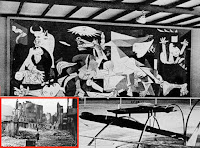The Francoist Dictatorship
THE FRANCOIST DICTATORSHIP (1939-1975):
 Ideological foundations of the regime: concentration of political power in Franco, anti-communism, traditionalism, militarism, anti-parliamentarism and anti-liberalism, fascist traits, national-patriotism, national-Catholicism, national-trade unionism ( Party-Single Union: FET de las JONS).
Ideological foundations of the regime: concentration of political power in Franco, anti-communism, traditionalism, militarism, anti-parliamentarism and anti-liberalism, fascist traits, national-patriotism, national-Catholicism, national-trade unionism ( Party-Single Union: FET de las JONS).
The political evolution of the dictatorship is divided into several stages:
And they approve the fundamental laws of the movement, a set of laws that synthesized the basic aspects of the Spanish political system (As a constitution does).
The economic transformations that were carried out were:
- In 1939, Spain was a country ruined by war, are given ration cards and the "Estraperlo" (black market) became the only means to acquire necessary goods.
- The solution of the regime was Autarky (1939-1951): Economic policy based on the search for economic self-sufficiency and state intervention.
- In 1945 the INI was created to promote the creation of industries and industrialize the country. This was achieved: to enhance the light industry versus the basic, the tendency to monopoly was strengthened, and the state was one of the big capital investors which allowed it to control the production.
- This led to several strikes which provoked the start of liberalization (1951-1956): It brought about a certain economic expansion and the prices were stabilized until 1956. The entry into the UN meant the economic openness of the regime.
- In 1959 the Stabilization Plan was created and its objectives were: price stability, flexibilization of economic activity and the release of economic relations with the outside world. The measures included were: the devaluation of the peseta and the suppression of the rigid state controls of the economy.
- From 1964 to 1975, three development plans were developed and their objectives were to: programme the growth of various sectors of the economy and promote the development of certain geographical areas; But the last one was abandoned coinciding with an international economic crisis in 1973.
- Of 1960-1973 There was a great economic development, with large foreign investments, a massive arrival of tourists and the elimination of unemployment through emigration to Europe.





Comentarios
Publicar un comentario